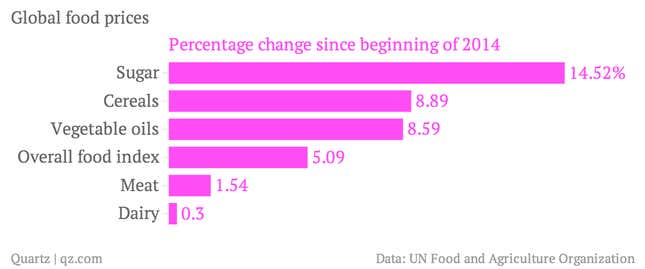The winter of 2014 hasn’t been kind to the cost of breakfast, lunch, and dinner.
Food prices have jumped more than 5% since the start of the year, according to the UN Food and Agriculture Organization’s food price index, which was updated this morning with new data for March. Sugar, cereals, and vegetable oils, in particular, have gotten significantly more expensive—by 8%, 5%, and 4%, respectively, since February; and nearly 15%, 9%, and 9%, respectively, since new years’ day.

The reason for the rising price of your food varies.
In the case of vegetable oil, for instance, it has a lot to do with pricier palm oil. Palm oil is the world’s most popular vegetable oil, but the vast majority of the world’s supply is produced by Indonesia and Malaysia, which together account for 85% of global production. The problem is that the world wants more of the stuff, which is used in half of all packaged food worldwide, and neither country has had an easy time upping its output.
The ongoing conflict between Russia and Ukraine has also pushed cereal prices up. “Geopolitical tensions in the Black Sea region, in particular uncertainties with regard to grain shipments from Ukraine, also provided a boost,” the FAO said on its website. Wheat and corn prices jumped 11% and 8% respectively in February alone.
The leading cause of pricier dinner plates, however, has been this season’s strange weather. “Last month’s increase was largely driven by unfavourable weather conditions affecting some crops,” according to the FAO.
Unusually dry conditions in Australia and the United States have slowed meat supply and driven up meat prices. Dry weather in Brazil and Thailand, both leading exporters of sugar, have led to spikes in sugar prices. In fact, dry, cold, hot, and generally unusual weather has played a part in the increasing price of just about every foodstuff this year. As we pointed out recently, commodities like coffee, pork, and oats are suffering the most at the hands of Mother Nature.




